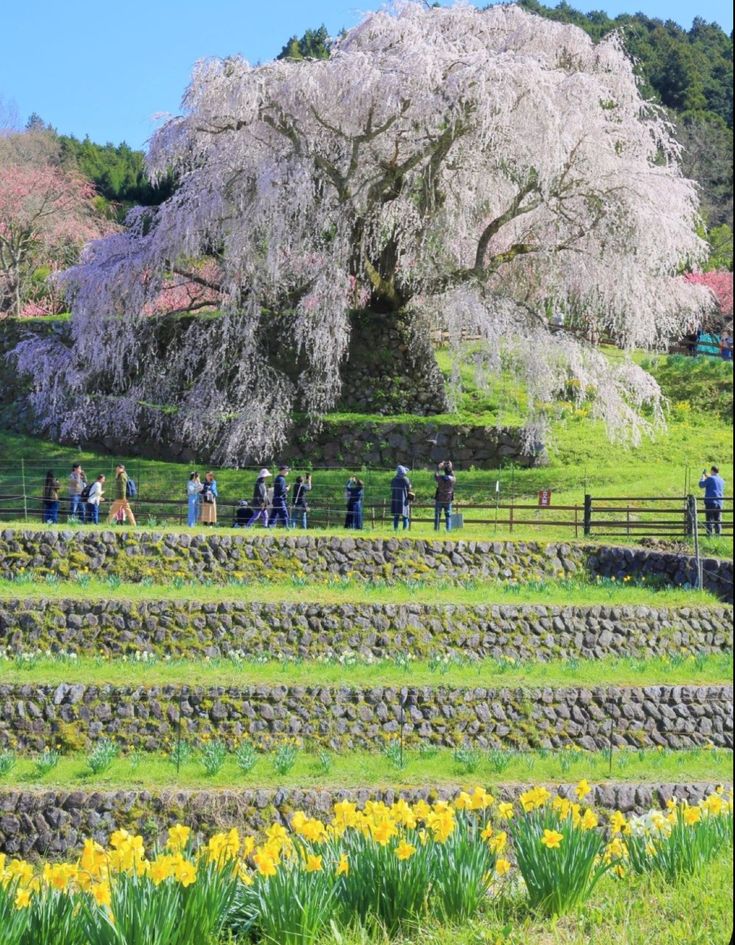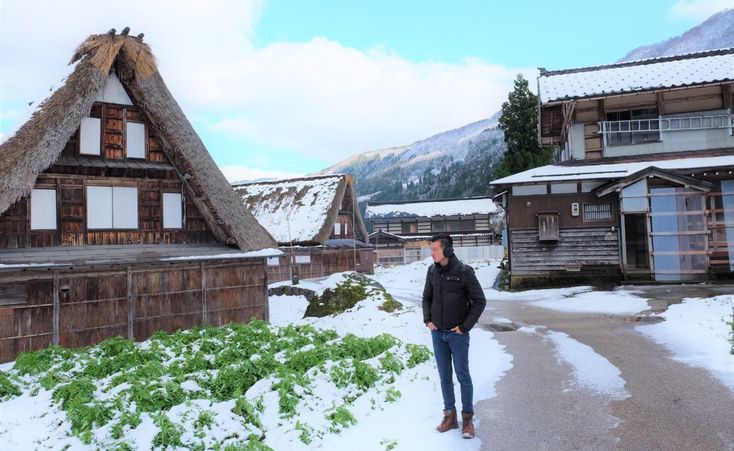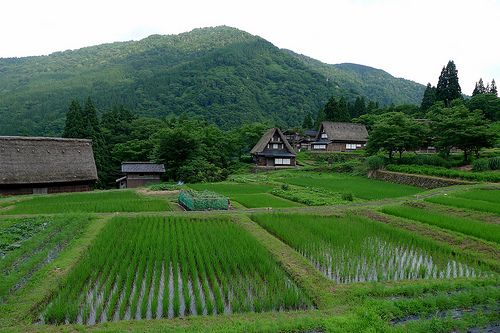The bus wheezed its way up the narrow, winding road, each turn revealing another breathtaking vista of Toyama Prefecture’s deep mountains. Hana, a young historian specializing in rural Japanese traditions, felt a thrill of anticipation. Her destination was Ainokura, a small, secluded village nestled within the larger Gokayama region, a UNESCO World Heritage site renowned for its beautifully preserved gassho-zukuri farmhouses and its steadfast adherence to a traditional way of life. She’d read about its commitment to handicrafts, its quiet dignity, and she was eager to experience it firsthand.
Stepping off the bus into Ainokura was like stepping into a meticulously crafted diorama of a bygone era. The village was a cluster of around twenty gassho-zukuri houses, their steep, thatched roofs like praying hands pointing towards a sky that seemed impossibly blue against the vibrant green of the surrounding slopes. There was an immediate sense of peace, a profound quiet broken only by the chirping of birds, the rustle of leaves, and the distant murmur of the Sho River. Unlike some heritage sites that felt like open-air museums, Ainokura pulsed with a gentle, lived-in energy. Smoke curled from a few chimneys, and laundry fluttered on a line behind one of the ancient homes.
Hana’s lodgings were in a minshuku run by an elderly couple, Mr. and Mrs. Nomura. Their gassho farmhouse, like all the others, was a marvel of traditional architecture, its massive wooden beams darkened by centuries of smoke from the central irori hearth. The air inside was cool and carried the faint, comforting scent of woodsmoke, tatami, and something subtly floral that Hana later learned was dried herbs hanging from the rafters.
“Welcome to Ainokura,” Mrs. Nomura said, her smile warm and genuine. “We live simply here, but we hope you find comfort.”
Hana quickly discovered that “living simply” in Ainokura meant a life rich in tradition and skill. The village wasn’t just preserving its buildings; it was actively maintaining the handicrafts and lifestyle that had sustained it for generations.

One of her first discoveries was a small workshop where a woman named Yuki-san practiced the art of Gokayama washi papermaking, a craft shared with the wider region. Hana watched, mesmerized, as Yuki-san expertly transformed mulberry bark into delicate, yet remarkably strong, sheets of paper. The rhythmic swish of the pulp in the vat, the careful lift of the screen, the gentle patting to remove excess water – it was a dance of precision and patience.
“Each sheet has its own character,” Yuki-san explained, holding a freshly made piece up to the light, revealing the intricate web of fibers. “It holds the spirit of the mountain water and the kozo tree. It’s a connection to our ancestors who developed this craft.”
Hana also learned about sasara-ko, a traditional percussion instrument unique to the region, made from dozens of small wooden plates strung together. One evening, Mr. Nomura brought his out, demonstrating the sharp, rustling sound it produced, a sound that was integral to the local folk songs and dances. He explained how the instrument was traditionally used to accompany rice planting songs, its rhythm mimicking the movements of the workers.
But it was the textile traditions that particularly captivated Hana. In several homes, she saw handlooms, some ancient, some more recent but still worked with meticulous care. Mrs. Nomura herself was a skilled weaver, creating beautiful fabrics from locally sourced hemp and silk, dyed with natural pigments from plants foraged in the surrounding mountains.
“Weaving is like telling a story,” Mrs. Nomura said, her fingers deftly guiding the shuttle through the threads. “Each thread is a part of our lives, our history. The patterns often reflect the nature around us – the flow of the river, the shape of the leaves, the color of the snow.”
Hana was invited to try her hand at a small loom. Her initial attempts were clumsy, the threads tangling, the tension uneven. But Mrs. Nomura was endlessly patient, her guidance gentle. Slowly, Hana began to understand the rhythm, the intricate interplay of warp and weft, the deep satisfaction of creating something beautiful and functional with her own hands. It was a stark contrast to the often-impersonal nature of modern academic research. Here, history was tangible, woven into the very fabric of daily life.

The community spirit in Ainokura was palpable. Life was interconnected. Neighbors helped each other with tasks big and small, from tending the communal vegetable patches to preparing for seasonal festivals. There was a sense of shared responsibility for maintaining not just the physical appearance of the village, but its cultural heart.
One afternoon, Hana climbed to the viewpoint overlooking Ainokura. The cluster of gassho-zukuri houses below, with their distinctive roofs, looked like a perfectly preserved jewel amidst the vastness of the mountains. She could see the terraced fields where rice and buckwheat were grown, testament to the villagers’ resourcefulness in cultivating the steep slopes. It was a landscape shaped by human hands, yet in complete harmony with nature.
She learned that Ainokura, despite its UNESCO status, faced challenges. The younger generation sometimes felt the pull of the cities, and maintaining the traditional skills required dedication and a willingness to embrace a quieter, more laborious way of life. Yet, there was a quiet determination among the villagers, a deep pride in their heritage. They weren’t just caretakers of the past; they were active participants in its continuation.
Hana’s time in Ainokura passed too quickly. She filled notebooks with observations, sketches, and transcriptions of stories shared by the villagers. She photographed the textures of thatch and aged wood, the intricate patterns of woven textiles, the expressive faces of the artisans. But more importantly, she felt a profound connection to the place and its people.
On her last evening, Mrs. Nomura presented Hana with a small, beautifully woven pouch. “A piece of Ainokura’s heart,” she said, her eyes twinkling. “So you remember the threads that connect us.”
Hana knew she would never forget. Ainokura, with its serene beauty, its steadfast commitment to traditional handicrafts, and its deeply woven community, had offered her more than just research material. It had shown her a way of life where history wasn’t confined to books, but was lived, breathed, and lovingly crafted every single day. The small, resilient village, nestled in the heart of the mountains, had woven its way into her own heart, leaving an indelible impression of beauty, tradition, and the enduring strength of the human spirit.
Hana began to find a rhythm in Ainokura that mirrored the steady, unhurried pace of the village itself. She’d wake to the soft light filtering through the paper shoji screens of her minshuku room, the distant sound of Mr. Nomura tending his small, meticulously kept garden, or the occasional clatter of Yuki-san already at work in her washi paper studio. The air, always fresh and tinged with the scent of cedar and damp earth, felt like a balm to her city-weary senses.
Her afternoons were often spent with Mrs. Nomura at her loom. The rhythmic clack and thump became a soothing backdrop to their conversations. Mrs. Nomura, sensing Hana’s genuine interest, began to share more than just the mechanics of weaving. She spoke of the symbolism woven into traditional patterns – the hemp leaf (asanoha) for resilience and growth, often used for children’s clothing; the interlocking circles (shippo) representing endless connection and harmony.
“These are not just pretty designs, Hana-san,” Mrs. Nomura explained, her gaze thoughtful as she adjusted a thread. “They are wishes, prayers woven into the cloth. When a mother wove for her child, she poured her hopes for their future into every strand.”

Hana, the historian, felt a profound connection to these stories. This was living history, far more vibrant and immediate than any dusty manuscript. She began to see the gassho-zukuri houses not just as architectural marvels, but as vessels of these accumulated wishes, their massive beams saturated with the stories and emotions of generations.
She also spent more time with Yuki-san at the washi workshop. Beyond the beauty of the finished paper, Hana became fascinated by the sustainable cycle of its creation. The kozo (mulberry) was cultivated locally, harvested with care, and every part of the process seemed to respect the natural materials. Yuki-san showed her how even the leftover pulp and water were sometimes used to enrich the soil in the village gardens. It was a closed loop, a harmonious give-and-take with the environment that felt deeply intuitive.
“In the city, things are often discarded after one use,” Yuki-san mused one day, carefully pressing a sheet of freshly made paper embedded with tiny, pressed wildflowers from the Ainokura hillsides. “Here, we try to see the value in everything, to use what the land gives us with gratitude, and to give back.”
Hana participated in small, everyday village activities. She helped Mrs. Nomura harvest vegetables from their terraced plot, her hands sinking into the rich, dark soil. She learned to identify different wild edibles during walks with some of the village women, who pointed out ferns, mountain shoots, and mushrooms with an ingrained knowledge passed down through time. These weren’t just quaint customs; they were essential survival skills honed over centuries of living in this isolated, sometimes harsh, environment.
One clear, crisp evening, some of the villagers gathered for an informal practice of the Kokiriko Bushi, one of Gokayama’s most famous folk songs and dances. Mr. Nomura played his sasara-ko, its sharp, rhythmic clapping cutting through the twilight air. Other villagers played bamboo flutes and small drums, while a few, both young and old, moved through the ancient, stylized steps of the dance. Their movements were not overtly polished or performative, but imbued with a deep, almost solemn, connection to the tradition. Hana watched, captivated, feeling the powerful pull of this shared cultural expression. It was a thread that bound them together, a living embodiment of their identity.
She also began to understand the quiet resilience of Ainokura. The village had weathered harsh winters, periods of economic hardship, and the constant lure of the modern world. Yet, it endured. This endurance, Hana realized, wasn’t born of stubbornness, but of a deep love for their heritage and a conscious choice to maintain a way of life that valued community, craftsmanship, and connection to the land above all else.
The children of Ainokura, though few in number, were a vital part of this continuity. Hana would often see them playing amongst the ancient houses, their laughter echoing. They were learning the traditions not through formal lessons, but through osmosis, by watching their elders, by participating in seasonal festivals, by simply growing up surrounded by the tangible evidence of their heritage.
Hana’s research notes became richer, imbued with personal anecdotes and sensory details – the exact shade of indigo Mrs. Nomura achieved with her natural dyes, the specific texture of Yuki-san’s washi paper embedded with autumn leaves, the haunting melody of a lullaby Mr. Nomura hummed while mending a fishing net. She realized her initial academic focus had broadened; she wasn’t just studying a village, she was learning from it.
As her departure approached, Hana felt a genuine sorrow. Ainokura had offered her a glimpse into a world where time moved differently, where human hands still held immense value, and where the bonds of community were as strong and essential as the massive wooden beams of the gassho-zukuri houses.
On her final morning, as the mist clung to the thatched roofs, giving the village an almost dreamlike quality, Hana walked through Ainokura one last time. She saw Yuki-san already at her workshop, the gentle sounds of papermaking beginning to drift out. She saw Mr. Nomura patiently weeding his garden. She saw the smoke rising from Mrs. Nomura’s chimney, a promise of warmth and sustenance.
The woven heart of Ainokura, she understood, was not just in its handicrafts or its stunning architecture. It was in the quiet dignity of its people, in their deep connection to their land and their traditions, and in the resilient threads of community that bound them together, generation after generation. It was a living tapestry, constantly being rewoven, yet always true to its ancient patterns. And Hana carried a piece of that precious fabric with her, a lasting inspiration for her own life and work.

